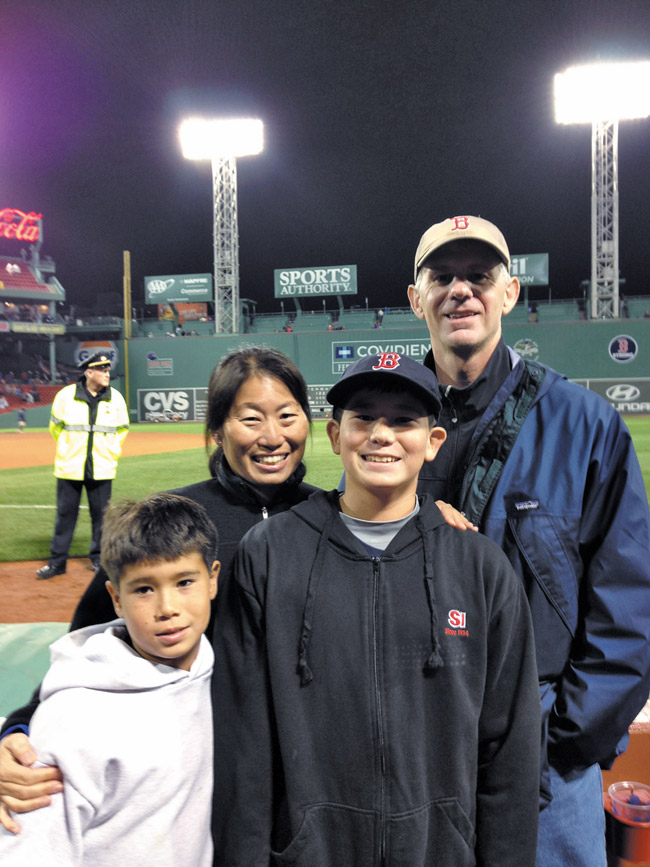Young Scientist’s Baseball Project
I received some wonderful comments about my recent column about visiting Boston’s historic Fenway Park for the first time.
One of my favorite responses came from Kimberly Svetin of Molokai, who also just got back from a game at Fenway with husband Todd and their two sons, Erik, 13, and Owen, 9.
“At the end of the top of each inning,” she writes, “Owen would stand up and wave his hands to Shane Victorino (right field) and Jacoby Ellsbury (center). In the fourth inning, Victorino caught a pop fly. He threw the ball to Ellsbury, who caught it under his leg (for show!). Owen is waving his arms and standing and yelling above the crowd, ‘Jacoby Ellsbury! Jacoby Ellsbury! Jacoby Ellsbury!’ Ellsbury pointed to Owen and threw the ball to a happy boy from Molokai. His official MLB ball is now on display in his bedroom.”
Baseball is a passion for the Svetin family. Dad Todd grew up in Maine and went to the University of New Hampshire, and is a lifelong Red Sox fan. (Todd is project manager of Goodfellow Bros. and is married to local girl Kimberly Mikami Svetin, who is a past valedictorian at Molokai High and now runs Mokokai Drugstore and Molokai General Store.) The family tries to attend a game or two on vacation visits to the Northeast. But there is more to the story linking the Svetins to baseball.
Oldest son Erik, who finished eighth grade at Molokai Middle School and enters Molokai High School as a freshman this fall, is an avid baseball player who used his love of the game to show off his skills as a student. Erik was the 2013 Hawaii State Merit Winner of the Young Scientist Challenge sponsored by Discovery Education and 3M. The Challenge is open to fifth-through eighth-graders to encourage interest in science.
“Baseball is my passion,” Erik tells me. “My science project was trying to see if adding a horizontal stitch to the baseball would effect the distance it travels.”
To complete the innovative project, which required a video to accompany it, Erik and his dad painstakingly cross-stitched a regulation baseball by hand and then treated the ends of the stitching so it wouldn’t unravel during flight.
“We borrowed a pitching machine from my coach and then launched the baseballs (a standard regulation baseball versus the newly stitched ball) at the Kaunakakai baseball field,” he says. “Our conclusion was that the (newly stitched) balls travel 2.8 percent farther than the standard ball.”
I had to ask a follow-up question: Uh, why?
“Stitching helps with flight,” he explains. “If you didn’t have it, a (smooth) baseball would react almost like a Ping-Pong ball and not go as far.”
I didn’t know that – probably because I had never really thought about it before. It took a 13-year-old with a curious mind to teach this old baseball fan something new. When I asked Erik if this meant he was going to become a scientist, he said not likely.
“I like statistics most,” he says. “I’d either like to become a statistician for a baseball team or a mechanical engineer.”
In the meantime, he will always be a Red Sox fan.
“They’re my favorite team,” he says. And Fenway is his favorite stadium. “I think it’s the best park ever. I love how it honors the game’s history.”
Erik honored the game with his own clever science invention, winning a Kindle Fire HD as the state’s top entry of the year, as well as the admiration of his teachers and friends in Molokai and this old sports columnist.
Check out Erik’s video: youtube.com/watch?v=xIn9fclceE4.
Fittingly, he’s wearing a Red Sox jersey during his delightful presentation. senatorbobhogue@yahoo.com






